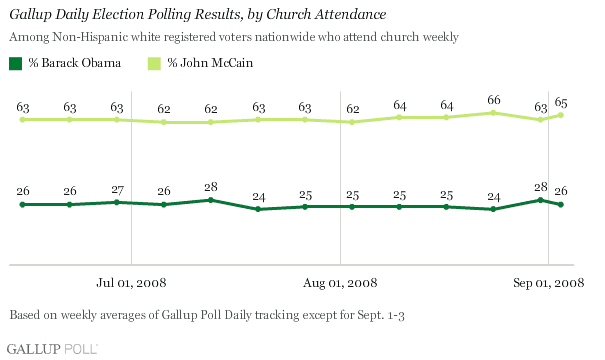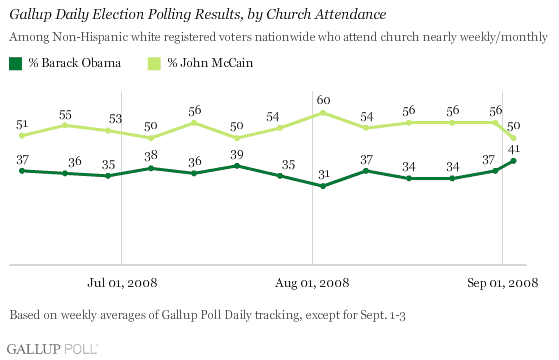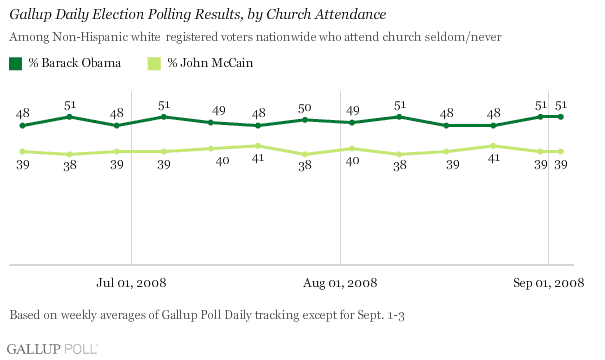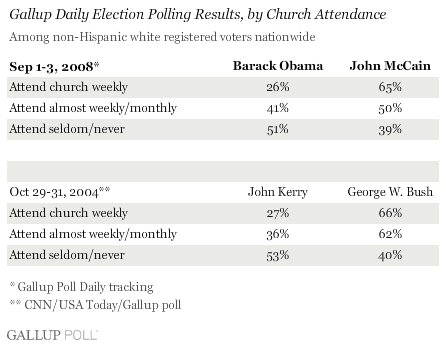PRINCETON, NJ -- John McCain has led Barack Obama all summer among highly religious white voters and continues to do so in the first three days of September, with no sign of change coincident with the selection of Alaska Gov. Sarah Palin as his vice-presidential running mate.

About 33% of non-Hispanic white registered voters are weekly church attenders, and the data make it clear that this group forms one of Republican McCain's key constituencies.
The more than 2-to-1 support levels for McCain among this group have been remarkably consistent all summer. Much attention was paid to the possibility that the choice of Palin would help boost McCain's support even further among this group. That may happen in the days to come, but interviewing conducted during the first three days of the Republican National Convention -- Monday through Wednesday -- suggests little change in support patterns among highly religious white voters compared to previous weeks. These religious voters remain about as supportive of McCain as they have been. (These data were mostly collected before Palin's speech on Wednesday night; any impact from that speech will not be apparent for several days.)
McCain also has the support of the smaller group of about 19% of white registered voters who attend church nearly weekly or monthly, but by a somewhat smaller margin. There has been a little more variation in support levels among this group as the summer has progressed, including a slight shift toward Obama in the Sept. 1-3 data.

Finally, there is a distinctly different pattern of candidate support evident among white voters who report seldom or never attending church.

This large group -- about 47% of the white registered voter population -- skews toward Obama by a 12-point margin in the last week of August and in the first three days of September. Again, there has been little substantive change in these voter support patterns all summer.
2004 Comparison
Indeed, this same pattern of candidate support by religiosity among whites has not only remained fairly constant this year, but is very close to where things stood four years ago, just before the 2004 election.

George W. Bush led John Kerry on the eve of the 2004 election by 66% to 27% among white registered voters who attended church weekly, almost identical to where McCain and Obama stand today. Bush did a little better than McCain is doing now among white voters who attend almost weekly/monthly, but the Kerry margin over Bush among infrequent church attenders and non-attenders in 2004 was very close to Obama's margin over McCain among this same group now.
Bigger Picture
Overall, in the first three days of September, McCain is winning over Obama among all non-Hispanic white registered voters by a 49% to 41% margin. This lead is based on the fact that his margin among the slightly more than half of all whites who attend church at least monthly is more than enough to compensate for his deficit among those who seldom or never attend church.
From a larger perspective, Obama has an overall lead of 7 points over McCain for Sept. 1-3. The Democratic nominee's support among nonwhites (including blacks, Hispanics, and Asians) is so strong that when averaged in with white voters, he comes out on top.
Implications
McCain has seen no immediate increase in support among highly religious white voters after his selection of Palin as his vice-presidential running mate. McCain has been ahead of Obama by better than a 2-to-1 margin among this group all summer, and that margin continues more or less unchanged in the first three days of September through Wednesday night. Meanwhile, Obama continues to dominate McCain among white voters who seldom or never attend church.
It should be reiterated that the data reviewed here do not yet reflect any possible impact of Palin's widely discussed acceptance speech on Wednesday night at the GOP Convention. Even if McCain does gain ground in the next several days as part of a positive reaction to Palin or the usual convention "bounce," it will be important to see whether he gains equally across all groups of white voters regardless of religion, or whether his gains are particularly concentrated in the highly religious group to which observers believe Palin may have a particularly strong appeal.
Also, the selection of Palin may serve the function of manifesting a change in enthusiasm and turnout propensity among various subgroups of voters. That is, highly religious white voters could now become more motivated than they have been in their support for the GOP ticket, and could therefore increase McCain's overall total vote count on Election Day. By the same token, the selection of Palin may generate increased enthusiasm among Obama's less religious supporters who likely disagree with her conservative views on social issues. All of this will be sorted out as Gallup continues to analyze data over the next several days.
Survey Methods
The general-election results are based on combined data from Sept. 1-3, 2008. For results based on this sample of 2,771 registered voters, the maximum margin of sampling error is ±2 percentage points.
Interviews are conducted with respondents on land-line telephones (for respondents with a land-line telephone) and cellular phones (for respondents who are cell-phone only).
In addition to sampling error, question wording and practical difficulties in conducting surveys can introduce error or bias into the findings of public opinion polls.
To provide feedback or suggestions about how to improve Gallup.com, please e-mail feedback@gallup.com.
